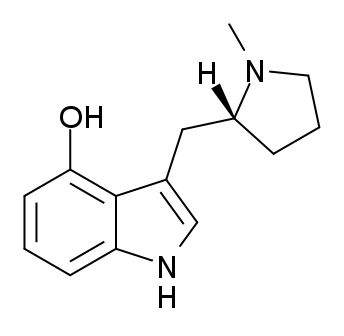Summary
4-HO-MPMI, alternatively referred to as 4-Hydroxy-N-methyl-(α, N-trimethylene)-tryptamine or lucigenol, belongs to the category of tryptamine derivatives and possesses psychedelic properties. Originating in the late 1990s, it was developed under the leadership of David Nichols at Purdue University. This compound exhibits hallucinogenic effects in animal trials, displaying potency akin to the amphetamine-derived psychedelic DOI. Notably, 4-HO-MPMI comprises two enantiomers, with only the (R)-enantiomer showing activity.
| Identifiers | |
|---|---|
| IUPAC name | |
| CAS Number | 250672-65-2 |
|---|---|
| PubChem CID | 10466404 |
| ChemSpider | 8641815 |
| UNII | 46OU9HLZ35 |
| CompTox Dashboard (EPA) | DTXSID80440389 |
| Chemical and physical data | |
| Formula | C14H17N2O |
| Molar mass | 229.303 g·mol−1 |

FAQ
1. What is 4-HO-MPMI?
- 4-HO-MPMI, also known as 4-Hydroxy-N-methyl-(α, N-trimethylene)-tryptamine or eugenol, is a psychedelic drug derived from the tryptamine family.
2. How was 4-HO-MPMI developed?
- 4-HO-MPMI was developed by a research team led by David Nichols at Purdue University in the late 1990s.
3. What are the effects of 4-HO-MPMI?
- 4-HO-MPMI is known to produce hallucinogenic effects. However, individual experiences may vary, and the results can range from altered perception to changes in mood and cognition.
4. Is 4-HO-MPMI legal?
- The legal status of 4-HO-MPMI varies by country and jurisdiction. In some places, it may be considered a controlled substance, so it’s essential to check local regulations and laws.
5. Are there any known safety precautions with 4-HO-MPMI use?
- Like other psychedelic substances, 4-HO-MPMI should be used with caution. It is advisable to start with a low dose in a safe and controlled environment, preferably with a sober and experienced sitter. It’s also important to be aware of potential interactions with other substances and any personal medical conditions.
6. Can 4-HO-MPMI be tested or analyzed for purity?
- Yes, various analytical methods can be employed to test the purity of 4-HO-MPMI. It’s essential to obtain substances from reputable sources and consider having them analyzed if you doubt their authenticity.
7. What are the different enantiomers of 4-HO-MPMI?
- 4-HO-MPMI consists of two enantiomers. Only the (R)-enantiomer is known to exhibit activity.
8. Are there any known medical uses for 4-HO-MPMI?
- 4-HO-MPMI is primarily considered a research chemical and is not approved for medical use. However, research into its potential therapeutic applications is ongoing.
9. Is 4-HO-MPMI similar to other psychedelics like psilocybin or LSD?
- 4-HO-MPMI is chemically related to other psychedelics like psilocybin and shares some similarities regarding its effects. However, each substance can have distinct properties and associated experiences.
10. Where can I find more information about 4-HO-MPMI?
References
- You can find more information about 4-HO-MPMI in scientific literature, research papers, and online resources on psychedelics and their properties. Always ensure that the information you access is from reputable sources.
- Gerasimov M, Marona-Lewicka D, Kurrasch-Orbaugh DM, Qandil AM, Nichols DE (1999). “Exploring Oxygenated Tryptamines with LSD-Like Effects: Incorporating a Chiral Pyrrolidine Moiety into the Side Chain”. Published in the Journal of Medicinal Chemistry. Volume 42, Issue 20, Pages 4257–4263. doi:10.1021/jm990325u. PMID 10514296.
- “Lucigenol Information on Hip Forums”. Archived from the original source on July 11, 2011. Retrieved on August 2, 2010.